|
Rialto
Author: Stefan Feld
Publisher: Pegasus Spiele
Year: 2013
review by

| x |
|
|
|
|
|
|
|
|
|
|
|
|
|
|
|
|
|
|
|
|
|
|
|
|
|
|
|
|
|
|
|
|
|
|
x |
|
|
|
|
|
|
|
|
|
|
|
|
|
|
|
|
|
|
|
|
|
|
|
|
|
|
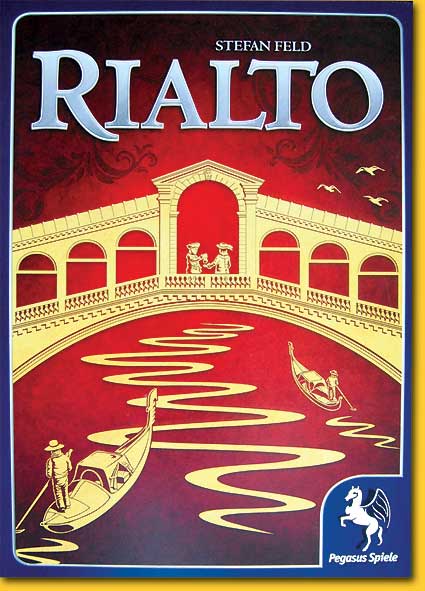 |
|
Let’s start with the box for a change. People with brains have thought long over this, such as: how will it stand against other boxes in a shelf situation? Does the game distinguish itself with this illustration? And yes, it does indeed, to answer the last question. Between the trend of atmospheric pictures of builders, Italian landscapes and noble figures, this illustration certainly can be called striking. It just feels like we have landed in the sixties or seventies, between 3M titles such asContigo, Twixt, Feudal and other abstract games, as far as both the atmosphere and the title. The stylized box illustration is somewhat reminiscent of a linocut, hence the association with the gilt-edges boxes of 3M. The illustration certainly does distinguish itself from the atmospheric boxes of other games, only: as a contrast it is rather bleak, and it feels quite cold and abstract.

|
|
|
|
|
|
|
|
|
|
|
|
|
|
|
| x |
|
|
|
|
|
|
|
|
|
|
|
|
|
|
|
|
|
|
|
|
|
|
|
|
|
|
|
|
|
|
|
|
|
|
|
|
|
|
|
|
|
|
|
|
|
|
|
|
|
|
|
|
|
|
|
|
|
|
|
|
|
|
A game that plays in Venice, justly needs the atmosphere, the intrigues; we should envision the dark alleys, and in the dark hear the water sloshing against the walls. A vague shadow in the distance. The atmosphere of ‘Don’t look now’ / ‘Wenn die Gondeln Trauer Tragen’.
When we open the box, we find a game board bearing the well-known map of Venice. But: the districts are also bleak coloured, and actually have only two colours in various shades due to a redundant rule that covers two bonuses. The only ‘suspense’ comes from the score track where some lanterns are lit against a night background with silhouettes of houses. Look good, because it’s rather small.
In six rounds the six districts are checked one by one, each game in a different sequence. Yes, the councelors are present again and they want just like the capos elsewhere in Italy but one thing: power, because this usually converts into money, and that is what the world makes go round, they say; so eventually it’s all for the good cause and in our own interest, innit?
|
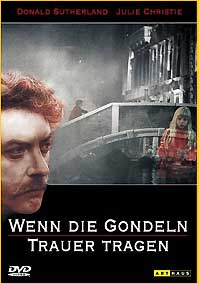 |
|
|
|
|
|
|
|
|
|
|
|
|
|
|
|
|
|
|
|
|
|
| x |
|
|
|
|
|
|
|
|
|
|
|
|
|
|
|
|
|
|
|
|
|
|
|
|
|
|
|
|
|
|
|
|
|
|
|
|
|
|
|
|
|
|
|
|
|
|
|
|
|
|
|
|
|
|
|
|
|
|
|
|
|
Players start with an initial building on their player board that they may activate during each and any of the rounds in the game by paying one gold; such a building could allow a player to hold an extra card in his hand, for instance. Because the placement of counselors is done by playing a specific card. Other cards allow taking money, building a bridge or building, or take influence at the doge track through which ties are resolved; it also serves to settle the player order for taking cards at the start of a new round.
|
|
|
|
|
|
|
|
|
|
|
|
|
|
|
|
|
|
| x |
|
|
|
|
|
|
|
|
|
|
|
|
|
|
|
|
|
|
|
|
|
|
|
|
|
|
|
|
|
|
|
|
|
|
|
|
|
|
|
|
|
|
|
|
|
|
|
|
|
|
|
|
|
|
|
|
|
|
|
|
|
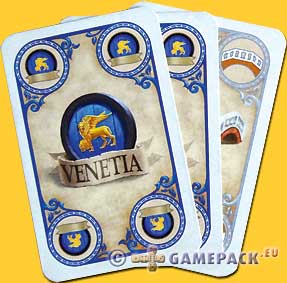 |
|
Each round, several rows of six cards are put on display, one more than participating players. After taking one of these rows, a player additionally may draw two blind cards but must end this pre-round with a maximum of seven cards in his hands - although the use of certain buildings could make an exception to this rule.
After this initial pre-round, the actual round starts and is worked in a fixed sequence. The initial starting player is the player who stands foremost on the doge track; he plays zero or more doge cards; the other players follow. After each round the starting player switches to the player who has played the most cards fort hat round; he also receives the bonus that goes with the card type that was played. |
|
|
|
|
|
|
|
|
|
|
|
|
|
|
|
|
|
| x |
|
|
|
|
|
|
|
|
|
|
|
|
|
|
|
|
|
|
|
|
|
|
|
|
|
|
|
|
|
|
|
|
|
|
|
|
|
|
|
|
|
|
|
|
|
|
|
|
|
|
|
|
|
|
|
|
|
|
|
|
|
| Then the money cards are played, after that the building, bridge and gondola cards and finally the counselor cards whose played number determines how many councelors from a players supply may be placed in the current quarter. During this whole phase of playing cards yellow buildings may be activated, but each must be paid for with a gold coin. Finally each player may activate one or more of his blue buildings, that simply do things such as scoring points, improve the position on the doge track, or upgrade a building. Buildings not only provide better possibilities during the game, but they also score their value at game end. |
|
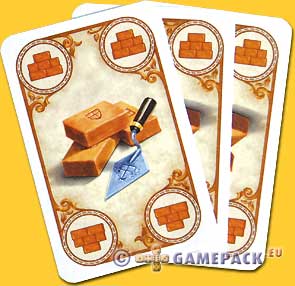 |
|
|
|
|
| x |
|
|
|
|
|
|
|
|
|
|
|
|
|
|
|
|
|
|
|
|
|
|
|
|
|
|
|
|
|
|
|
|
|
|
|
|
|
|
|
|
|
|
|
|
|
|
|
|
|
|
|
|
|
|
|
|
|
|
|
|
|
 |
|
|
|
| x |
|
|
|
|
|
|
|
|
|
|
|
|
|
|
|
|
|
|
|
|
|
|
|
|
|
|
|
|
|
|
|
|
|
|
|
|
|
|
|
|
|
|
|
|
|
|
|
|
|
|
|
|
|
|
|
|
|
|
|
|
|
| But these aren’t the only points to be scored, the councelors in their quarters score too. Both sides of a placed bridge that connect two quarters have a number. When a player places a bridge, having played the most bridge cards, he may choose any free position between two quarters; the current quarter doesn’t necessarily has to be involved. A player who has played the most gondola cards may place a gondola, in fact also a bridge; only the gondola has only a value ‘1’ on both sides. |
|
|
|
|
|
|
|
| x |
|
|
|
|
|
|
|
|
|
|
|
|
|
|
|
|
|
|
|
|
|
|
|
|
|
|
|
|
|
|
|
|
|
|
|
|
|
|
|
|
|
|
|
|
|
|
|
|
|
|
|
|
|
|
|
|
|
|
|
|
|
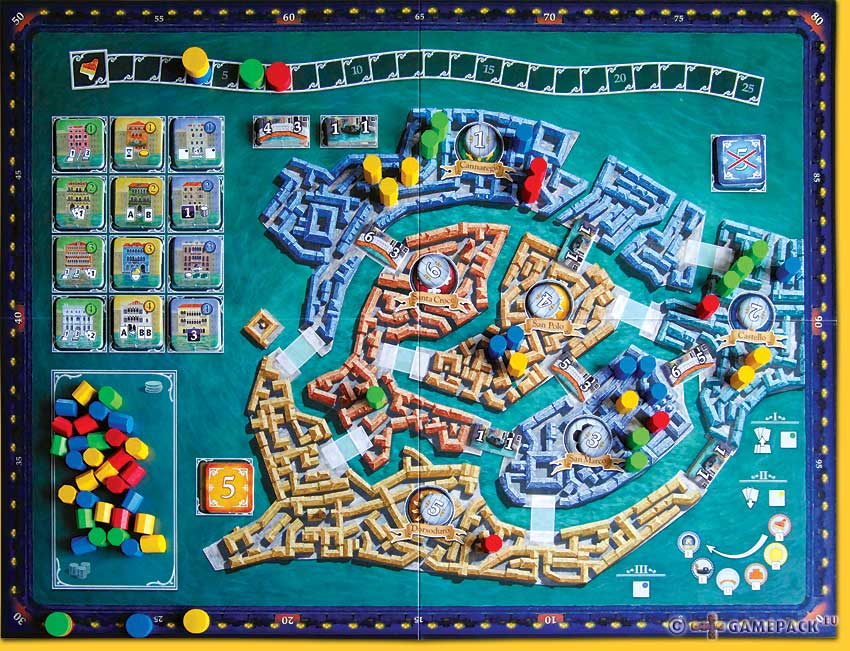 |
|
|
| x |
|
|
|
|
|
|
|
|
|
|
|
|
|
|
|
|
|
|
|
|
|
|
|
|
|
|
|
|
|
|
|
|
|
|
|
|
|
|
|
|
|
|
|
|
|
|
|
|
|
|
|
|
|
|
|
|
|
|
|
|
|
|
At the end of the game all six quarters are scored; all numbers connected with a quarter are added and these points go to the player with the majority of councelors in this quarter. A second place gets half the points, rounded down, a third position halved points again and rounded down, and so on. The player with the most points, let’s have a look in the rules: becomes the secret Eminence of Venice! So, keep your mouth shut and don’t tell anyone, because secret!
|
|
|
|
|
|
|
|
| x |
|
|
| x |
|
|
| x |
|
|
 |
|
|
|
|
|
|
|
|
|
|
|
|
|
|
|
|
|
|
|
|
|
|
|
|
|
|
|
|
|
|
|
|
|
|
|
|
|
|
|
|
|
|
|
|
|
|
|
|
|
|
|
|
| We already were disappointed by the game’s first sight, and except for the cards that have a top-notch look, there is little splendor to be experienced. It is hard to believe that the beautiful illustrated cards are of the same maker as the uninspired board and the spiritless player board. As beautiful as the cards are, the rest should have been done. Playing a game all is about atmosphere. We can make it ourselves, it can be offered by mechanisms within the game, but it also can be cranked up, helped or enhanced by the implementation. Unfortunately, the execution is miserable, in this case. |
|
|
|
|
|
|
|
|
|
|
|
|
|
|
|
|
|
| x |
|
|
|
|
|
|
|
|
|
|
|
|
|
|
|
|
|
|
|
|
|
|
|
|
|
|
|
|
|
|
|
|
|
|
|
|
|
|
|
|
|
|
|
|
|
|
|
|
|
|
|
|
|
|
|
|
|
|
|
|
|
 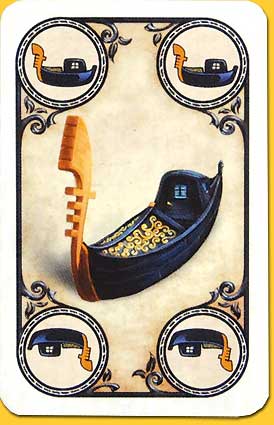 |
|
|
|
|
|
|
|
|
|
|
|
|
|
|
|
|
|
|
|
|
| x |
|
|
|
|
|
|
|
|
|
|
|
|
|
|
|
|
|
|
|
|
|
|
|
|
|
|
|
|
|
|
|
|
|
|
|
|
|
|
|
|
|
|
|
|
|
|
|
|
|
|
|
|
|
|
|
|
|
|
|
|
|
| A first thought at the sight of ‘Rialto’ is: ‘Hey, another game that plays in Venice!’ ‘Yes, or in Florence, at the French court or in medieval England’, could be rebutted. But the resemblance to ‘San Marco’ immediately arises, in regard to the acquisition of power in the various districts. Only ‘San Marco’ has a much more briljant mechanism - and a beautiful, atmospheric, arty board, and real bridges. |
|
|
|
|
|
|
|
|
|
|
|
|
|
|
|
|
|
| x |
|
|
|
|
|
|
|
|
|
|
|
|
|
|
|
|
|
|
|
|
|
|
|
|
|
|
|
|
|
|
|
|
|
|
|
|
|
|
|
|
|
|
|
|
|
|
|
|
|
|
|
|
|
|
|
|
|
|
|
|
|
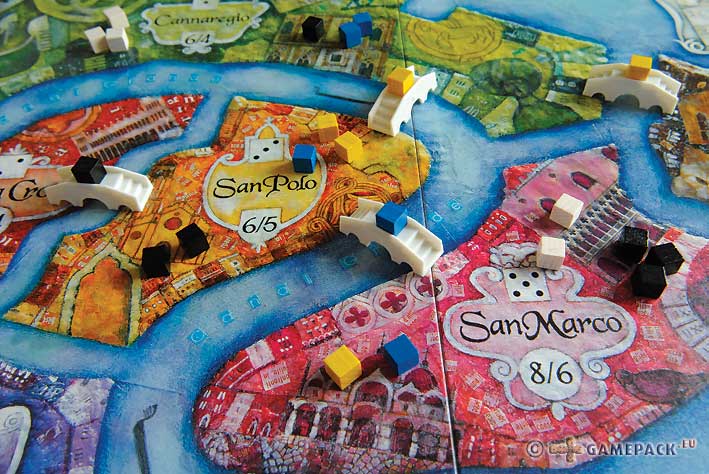 |
|
|
| x |
|
|
|
|
|
|
|
|
|
|
|
|
|
|
|
|
|
|
|
|
|
|
|
|
|
|
|
|
|
|
|
|
|
|
|
|
|
|
|
|
|
|
|
|
|
|
|
|
|
|
|
|
|
|
|
|
|
|
|
|
|
| That a game about Venice all is about atmosphere was well understood by the makers of ‘Inkognito’; here a very innovative and impressive mechanism was invented that indicated a players possibilities in a turn, with players pawns all being mysterious carnival goers. It is just that the game at the time, in 1988, received a special prize - Sonderpreis Schönes Spiel / Special Prize Beautiful Game - for it from the Spiel des Jahres jury. |
|
|
|
|
|
|
|
|
|
|
|
|
|
|
|
|
|
 |
|
|
| x |
|
|
|
|
|
|
|
|
|
|
|
|
|
|
|
|
|
|
|
|
|
|
|
|
|
|
|
|
|
|
|
|
|
|
|
|
|
|
|
|
|
|
|
|
|
|
|
|
|
|
|
|
|
|
|
|
|
|
|
|
|
No, in ‘Rialto’ players are stuck with flat card board chits on a pale board. Isn’t is allowed anymore to include fancy plastic material, nowadays?
But the game itself then, how does that play? Well, just as boring, as a matter of fact. It functions, could be a devastating remark. But there is no spark, no tension. Players do something, and they do it five more times. Done. Did they sit on the edge of their seats? No. Was there a ‘take that’ moment? No again. Did they exhaust themselves in making cunning plans? Nope. |
|
|
|
|
|
|
|
|
|
|
|
|
|
|
|
|
|
| x |
|
|
|
|
|
|
|
|
|
|
|
|
|
|
|
|
|
|
|
|
|
|
|
|
|
|
|
|
|
|
|
|
|
|
|
|
|
|
|
|
|
|
|
|
|
|
|
|
|
|
|
|
|
|
|
|
|
|
|
|
|
 |
|
|
|
|
‘Rialto’ is, is must be said, a rather lifeless and little original game. Throw it on a heap and try to find it back again, will find one busy for quite some time. When ‘Rialto’ has aspirations of moving in the higher glamorous circles of Venice, it actually got stuck in the masses of tourists and guides with umbrellas. A doge is nowhere to be seen...
© 2013 Richard van Vugt
Rialto, Stefan Feld, Pegasus Spiele, 2013 - 2 to 5 players, 10 years and up, 45-60 minutes
|
|
|
|
|
|
|
|
|
|
|
|
|
|
|
|
|
|
  |
|
|
|
|
|
|
|
|
|
|
|
|
|
|
|
|
|
|
|
|
|
|
|
|
|
|
|
|
|
|
|
|
|
|
|
|
|
|
|
|
|
|
|
|
|
|
|
|
|
|
|
|
  |
|
|
|
|
|
|
|
|
|
|
|
|
|
|
|
|
|
|
|
|
|
|
|
|
|
|
|
|
|
|
|
|
|
|
|
|
|
|
|
|
|
|
|
|
|
|
|
|
|
|
|
|
  |
|
|
|
|
|
|
|
|
|
|
|
|
|
|
|
|
|
|
|
|
|
|
|
|
|
|
|
|
|
|
|
|
|
|
|
|
|
|
|
|
|
|
|
|
|
|
|
|
|
|
|
|
  |
Kind of crossover between 'San Marco' and 'Strasbourg', but doesn't reach the level of both |
|
|
|
|
|
|
|
| x |
|
|
|
|
|
|
|
|
|
|
|
|
|
|
|
|
| x |
|
|
|
|
|
|
|
|
|
|
|
|
|
|
|
|
|
|
|
|
|
|
|
|
|
|
|
|
|
|
|
|
|
|
|
|
|
|
|
|
|
|
|
|
|
|
|
|
|
|
|
|
|
|
|
|
|
|
|
|
|
 |
|
|
|
|
|
|
|
|
|
|
|
|
|
|
|
|
|
|
|
|
|
|
|
|
|
|
|
|
|
|
|
|
|
|
|
|
|
|
|
|
|
|
|
|
|
|
|
|
|
|
|
|
 |
|
|
|
|
|
|
|
|
|
|
|
|
|
|
|
|
|
|
|
|
|
|
|
|
|
|
|
|
|
|
|
|
|
|
|
|
|
|
|
|
|
|
|
|
|
|
|
|
|
|
|
|
| x |
|
|
|
|
|
|
|
|
|
|
|
|
|
|
|
|
|
|
|
|
|
|
|
|
|
|
|
|
|
|
|
|
|
|
|
|
|
|
|
|
|
|
|
|
|
|
|
|
|
|
|
|
|
|
|
|
|
|
|
|
|
 |
|
|
|
|
|
|
|
|
|
|
|
|
|
|
|
|
|
|
|
|
|
|
|
|
|
|
|
|
|
|
|
|
|
|
|
|
|
|
|
|
|
|
 |
|
|
|
|
|
|
|
|
|
|
|
|
|
|
|
|
|
|
|
|
|
|
|
|
|
|
|
|
|
|
|
|
|
|
|
|
|
|
|
|
|
|
|
|